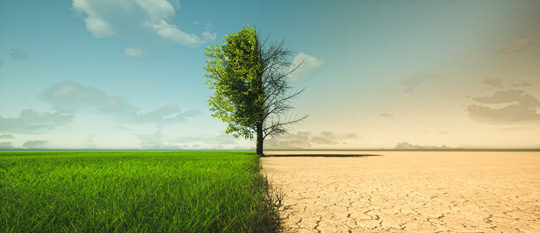How past societies adapted to climatic changes
Freiburg, Nov 19, 2021
During the time of the Little Ice Age, it was often quite uncomfortable, with many a harsh winter, long periods of drought, and rainy, cool summers. This lasted from the 13th to the 19th century and brought about some climatic changes after the previously prevailing medieval warm period. Although these were less pronounced than the climate change we are experiencing today, societies at the time still had to deal with them. An international research team, including Katrin Kleemann from the Chair of Economic, Social and Environmental History at the University of Freiburg, has presented a framework for studying the history of climate and society in the renowned journal Nature. In it, they identify five pathways, known as resilience pathways, that pre-modern populations used to adapt to climate change.

Also in pre-modern times, people had to adapt to climatic changes. Photo: appledeign/stock.adobe.com
“A lot of studies are primarily concerned with disasters and why a society collapsed,” Kleemann says. “We wondered if the responses to climatic changes in particular might have been more complex than is sometimes suggested.” Even if they weren’t always major catastrophes, the climate still changed enough that it affected people’s lives. To get the most comprehensive view possible, scientists from different disciplines have joined forces: historians study historical sources, natural scientists contribute knowledge from ice core drillings, statisticians read the numbers. “For example, events from written sources can be confirmed with the findings from tree ring analyses,” Kleemann explains. “Conversely, information from dendrochronologists can sometimes be made more precise by historians.”
Warnings through bell ringing or cannon fire
So how did past societies deal with natural - and less severe - climate change? And can we possibly draw lessons from this for how we deal with modern climate change? This is well illustrated by the example of floods, which Kleemann examines. It is already clear that the so-called floods of the century will occur more often in the future than just once every 100 years due to climate change. As a result, preparing for them would be wise. In the 18th century, insurance was not yet widespread, so people affected by floods back then had to work much harder to compensate for the damage caused. Moreover, contemporary societies benefit from a sophisticated early warning system and regular measurement of water levels. In the past, the warning system was based on ringing bells or firing cannons: downstream communities were signaled in this way that water - and sometimes ice - was approaching. Using the example of the ice floods of Cologne in the spring of 1784, the Freiburg historian thus shows the resilience pathway of political and institutional adaptation. “People who no longer had shelter were quartered in houses by official decree. Millers received flour from the city, from which they baked bread, which was provided free of charge to the population. And the Lutheran and Catholic churches collected donations and distributed food,” Kleemann recounts.
The eruption of the Icelandic Laki Fissure possibly caused the cold winter of 1783/1784. It had already begun in June 1783. About 15 cubic kilometers of lava were released over eight months, and many gases entered the strato- and troposphere and reached Europe with the jet stream. “You could see it in the form of dry fog, and you could smell some of it,” Kleemann says. “For people at that time, it must have been very disturbing. They were able to observe all the changes without knowing where they were coming from.”
New infrastructure and rules in response
Completely unprepared, Europe was already hit once in the middle of the 13th century by a completely changed climate: The summer of 1258 was stormy, cold and rainy, and there were crop failures and floods. The reason for this was the eruption of the stratovolcano Samalas in 1257 on the Indonesian island of Lombok. „Sediments ejected at that time could be detected in ice core drillings, which matched the historical records from that time, which reported stormy and cold weather conditions,” Kleemann relates. In Italy, on the other hand, major famines and consequent high mortality were avoided because people adapted. They imported more grain and built new granaries specifically for this purpose, from which the food was then rationed. “Here we can clearly see how a new infrastructure and new rules emerged in response to a change in climate,” Kleemann explains. At the same time, the Samala outbreak had a much more severe impact in Asia than it did here, with entire villages in Indonesia wiped out. Because local impacts can vary so much, the researchers always keep a triad in mind: climate history, regional events and the respective local societal response.
With the study and new framework now published, the scientists aim to encourage other researchers to explore connections between climate and society. “This is a growing field in which we are gradually gaining new insights and in which there is also a lot of potential for new studies,” says Kleemann. “Because even though we have far better technical capabilities today than people had a few hundred years ago, we can learn for the future if we understand the past better, which means, above all, seeing it more realistically.”
Claudia Füßler
Press release from MPI for the Science of Human History about the paper

